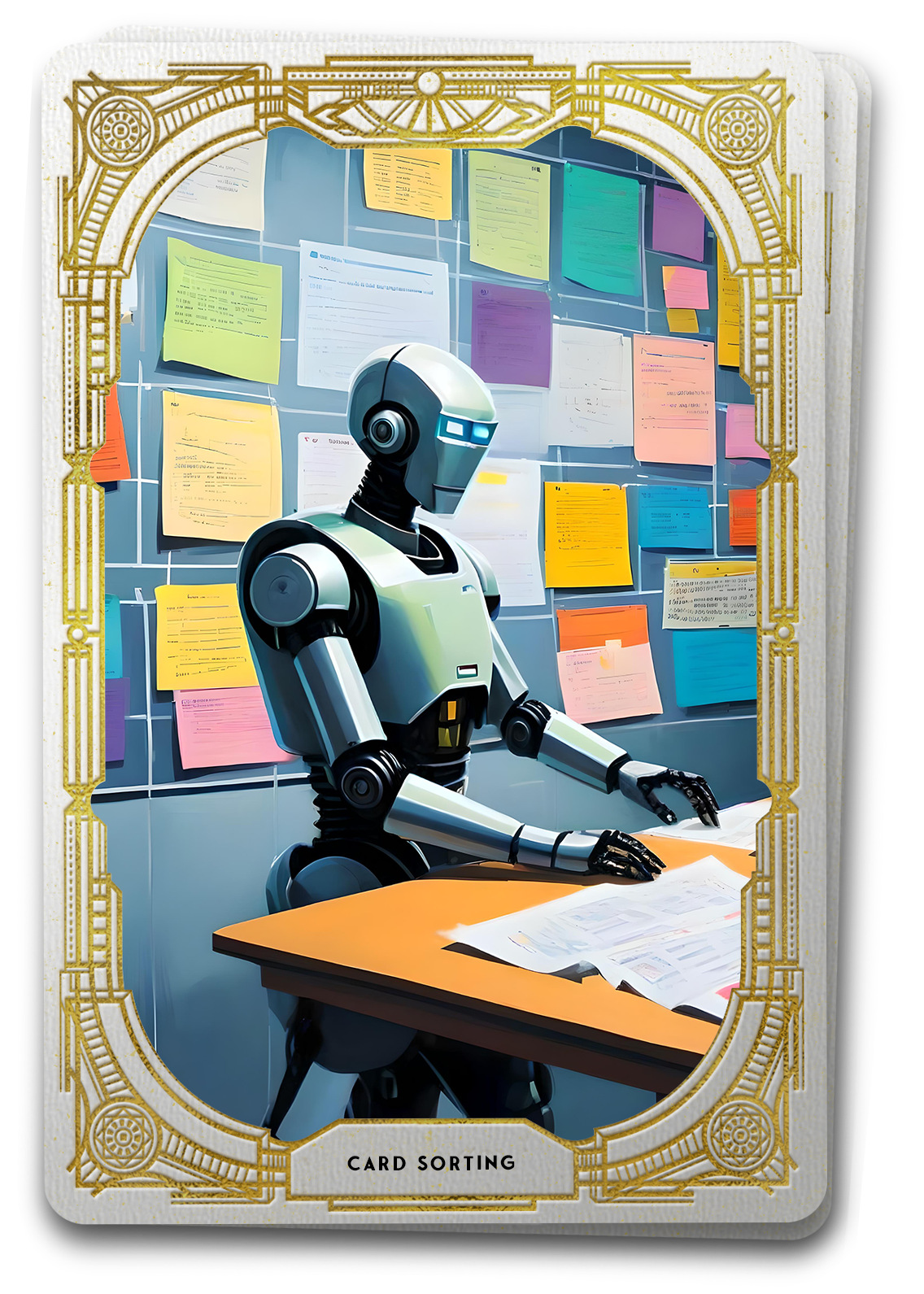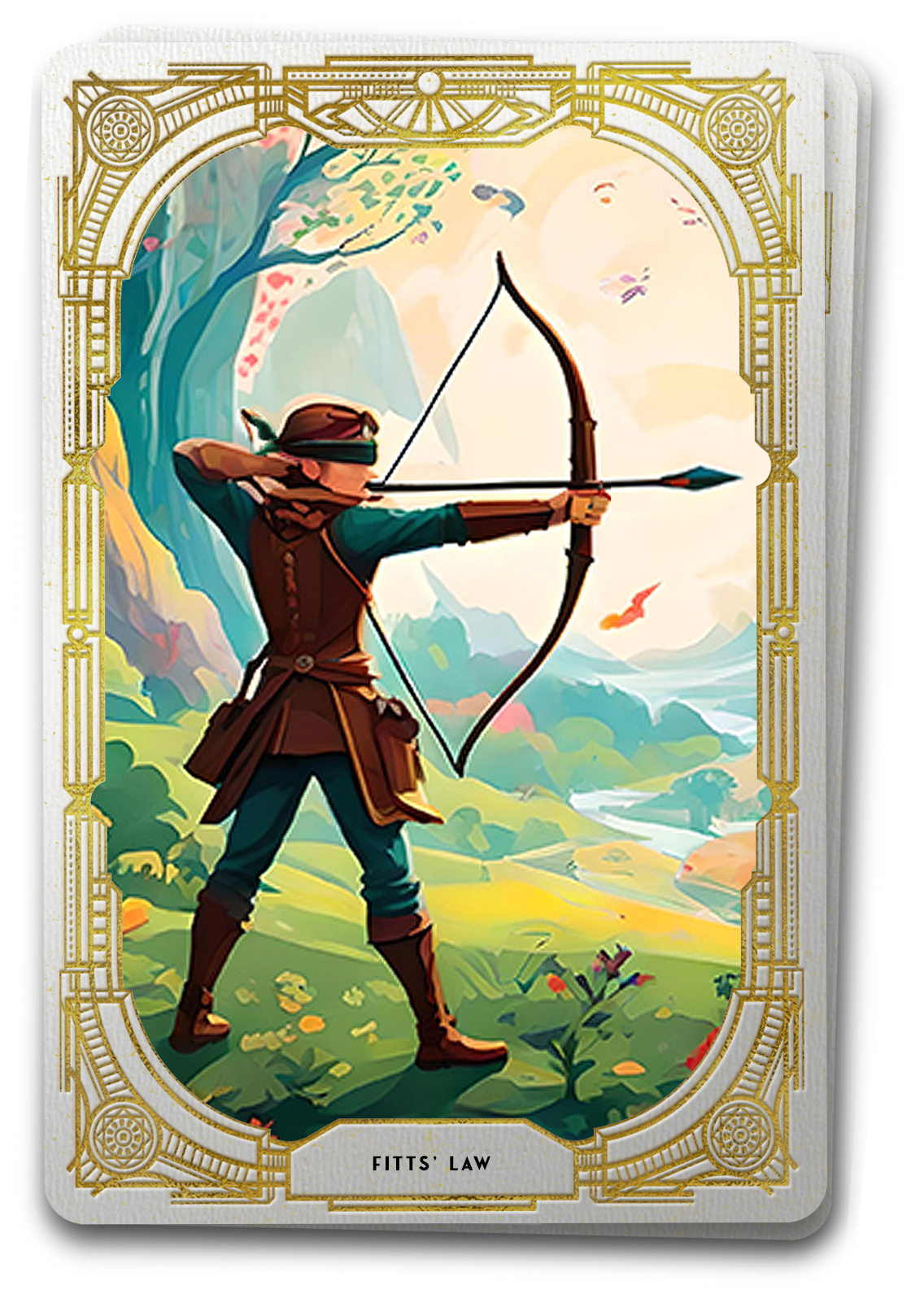
The Tarot Reveals Card Sorting:
An index card, a pen, and a user can be your most valuable tools.
Imagine you’re programming a robot to organize a vast array of information into coherent categories. Each piece of data is like a puzzle piece, waiting to be sorted and arranged according to the robot’s algorithm. You can use your experience, best guess, and common sense to organize this information, but the real magic lies in yielding the tools of organization to your users – effectively allowing them to guide the robot through the labyrinth of user expectations and preferences. Welcome to card sorting.
Card sorting, in essence, is like peering into the minds of users, offering a glimpse into their mental models and cognitive processes. By observing how users naturally organize and categorize information, designers gain invaluable insights into their expectations and preferences. This process serves as a bridge between the designer’s vision and the user’s perception, allowing for the creation of digital experiences that feel intuitive and seamless.
The roots of card sorting stretch back to the dawn of cognitive psychology, where researchers sought to understand how humans organize and categorize information. In the digital era, the technique gained prominence in user experience design, thanks to the pioneering work of researchers like Donna Spencer and Jakob Nielsen. Through meticulous experiments and observations, they uncovered the fundamental principles that underpin effective information architecture.
Early studies in card sorting revealed that users tend to organize information based on similarity, relevance, and hierarchical structure. This insight laid the groundwork for the development of card sorting as a research technique in user experience design. Today, card sorting has evolved into a versatile tool used across various domains, from website navigation design to content organization in mobile apps.
The Art of Organizing
At its core, card sorting is a collaborative endeavor between users and designer. Users are presented with a set of virtual cards, each representing a topic, concept, or piece of information. Users arrange these cards into groups that make sense to them, illuminating their mental models and expectations.
The process of card sorting can take various forms, from open card sorting, where users are free to create their own categories, to closed card sorting, where users must organize cards into predefined categories. Each approach offers unique insights into user behavior and preferences, guiding designers in crafting information architectures that align with user expectations. Additionally, hybrid methods, such as hybrid card sorting, combine elements of both open and closed approaches, offering a flexible framework for gathering user input.
The insights gleaned from card sorting lay the foundation for crafting an information architecture that resonates with users’ mental models. By understanding how users naturally categorize information, designers can orchestrate navigation pathways that guide users effortlessly through the digital landscape. From intuitive menu structures to logical content groupings, every element is crafted to align with user expectations, transforming a cacophony of information into a harmonious melody of usability.
The process of card sorting doesn’t end with the organization of cards; it extends to the analysis and interpretation of user-generated structures. Designers must analyze the resulting clusters, identifying patterns, outliers, and areas of confusion. These insights inform iterative design decisions, guiding refinements to the information architecture and user interface design. Through continuous testing and refinement, designers can ensure that the final product not only meets but exceeds user expectations, fostering a sense of flow and engagement in every interaction.
Navigating the Digital Labyrinth
In the ever-expanding discipline of digital experience, card sorting serves as a compass, guiding designers through the labyrinth of user expectations. Whether mapping out a website’s navigation menu or streamlining the menu options in a mobile app, the insights derived from card sorting empower designers to create experiences that feel intuitive and effortless to users.
As technology continues to evolve and user preferences shift, the principles of card sorting remain as relevant as ever. Designers should not only embrace the collaborative spirit of card sorting, but should willingly hand over the reigns by engaging users in the design process and valuing their input. By incorporating user feedback and insights into the design process, designers can create digital experiences that not only meet but anticipate the needs and expectations of their audience.
Conducting a Card Sort: Methodology
Preparation
Define the goals and objectives of the card sorting exercise, select appropriate card sorting method (open, closed, or hybrid), and identify the target audience for participation.
Card Creation
Create a set of cards representing topics, concepts, content, or tasks relevant to the project. Each card should contain a clear and concise description to facilitate understanding.
Recruitment
Recruit participants who represent the target audience or user demographic. Provide clear instructions and guidelines for the card sorting exercise.
Execution
Conduct the card sorting sessions, either in person or remotely using specialized software, index cards, or even Post-It notes. Encourage participants to organize the cards into groups that make sense to them, emphasizing natural grouping and avoiding predefined categories.
Analysis
Analyze the results of the card sorting sessions, identifying common patterns, outliers, and areas of confusion. Consider factors such as grouping consistency, card placement, and participant comments.
Iterative Design
Use the insights gathered from the card sorting exercise to inform iterative design decisions. Refine the information architecture, navigation structure, and content organization based on user feedback and preferences.
Validation
Validate the revised design through further testing and feedback gathering. Iterate as necessary to ensure the final product aligns with user expectations and enhances the overall user experience.




